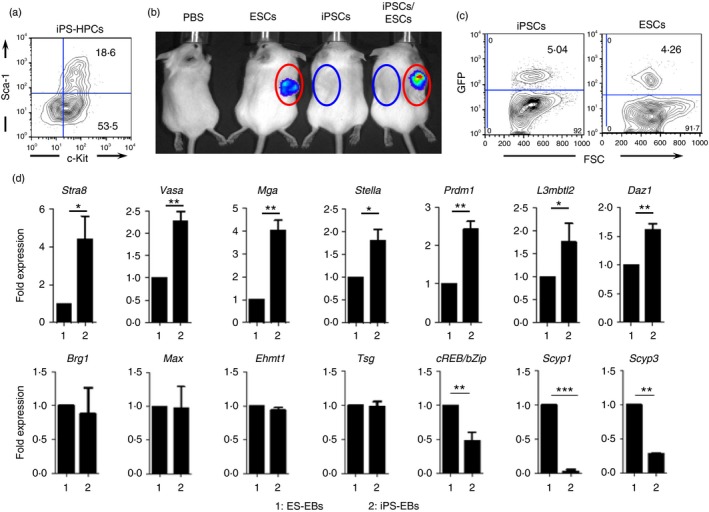Figure 2.

Meiotic and spermatogenetic genes expressing induced pluripotent stem cells (iPSC) embryoid bodies (EBs) are rejected in syngeneic mice. (a) To determine, whether iPSC derivatives are rejected in syngeneic mice like iPSCs, we differentiated the 129x1/SvJ iPSCs into haematopoietic progenitor cells (HPCs). These iPSC‐derived HPCs express sca‐1+/c‐kit+, which are haematopoietic progenitor markers, indicating that those iPSCs are successfully differentiated into HPCs. (b) To determine whether iPSC‐derived HPCs engraft in syngeneic mice, 129x1/SvJ mice were sublethally irradiated and transplanted with the 129x1/SvJ iPS‐HPCs. After that, these mice were subsequently injected with 129x1/SvJ iPSCs, embryonic stem cells (ESCs) or with both, subcutaneously. The luminescence emitted by the teratomas (21 days post transplantation) are shown if they are not rejected (circles denote original injection sites). Mice transplanted with luciferase‐expressing iPSCs either singly or together with luciferase‐expressing ESCs rejected iPSCs, but not ESCs (Each group of mice comprised 10 mice, and these experiments were repeated four times). However, GFP‐expressing iPS‐HPCs were detected in chimeric mice long term in the peripheral blood system (6 weeks after iPSC transplantations) (c). To identify the genes that are differently expressed, we performed quantitative PCR analysis expression between iPSCs and ESCs. (d) iPS‐EBs but not ES‐EBs strongly expresses genes involved in meiosis and spermatogenesis (top row). In particular, Stra8, Vasa and Mga were strongly expressed in iPS‐EBs compared with in ES‐EBs. The genes displayed in the lower row either remained unchanged or were down‐regulated. These quantitative PCR experiments were repeated at least four times in triplicates. ***P < 0·001, **P < 0·01 and *P < 0·05. [Colour figure can be viewed at wileyonlinelibrary.com]
